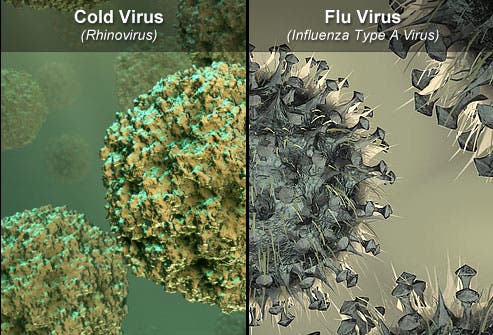
It’s common to dismiss a few sniffles and a cough as ‘nothing but a cold’ when, in fact, it might very well be a far more dreadful animal — influenza. It’s quite easy to mistake the two, too. Both are viral infections and symptoms often overlap. Sometimes, unless your doctor runs a test with a cotton swab from the back of your nose or throat, it can be very difficult to tell the two apart. Make no mistake though — the two types of viral infections can also be worlds apart, so much so that it could mean the difference between life and death. While the common cold is generally harmless, tens of thousands of people worldwide die each year from the flu.
Flu vs common cold
Flu symptoms include:
- Fever or feeling feverish/chills
- Cough
- Sore throat
- Runny or stuffy nose
- Muscle or body aches
- Headaches
- Fatigue (tiredness)
- Some people may have vomiting and diarrhea, though this is more common in children than adults.
Cold symptoms overlap greatly, but they’re typically milder than those of the flu. Another important difference in this regard is that people with colds are more likely to have a runny or stuffy nose.
Precisely because the symptoms of the two types of infection overlap so much, it can be very difficult if not impossible to diagnose one or the other based on symptoms alone. Instead, doctors rely on special tests performed within the first couple of days of illness to make the diagnosis. It’s a good idea to get tested within the first 48 hours of showing symptoms to minimize the risk of developing flu-related health complications.
The flu can lead to sinus and ear infections (moderate) or more serious complications such as pneumonia, inflammation of the heart (myocarditis), brain (encephalitis) or muscle (myositis, rhabdomyolysis) tissues, and multi-organ failure (for example, respiratory and kidney failure). Colds generally do not result in serious health problems.
Both the flu (influenza) and the common cold are viral infections of the upper respiratory tract but each is caused by different groups of viruses. However, influenza can also infect the lungs and the joints, and can cause pneumonia, respiratory failure, and even death.

Colds come on gradually over a few days and are often milder than the flu. They usually get better in 7 to 10 days, although symptoms can last for up to 2 weeks.
Flu symptoms come on quickly — often within 1 to 3 days — and can be severe. Basically, if you wake up one morning suddenly feeling like you’ve been hit by a truck, it’s likely the flu. Symptoms usually last 1 to 2 weeks.
Influenza is responsible for body and head aches, whereas cold aches are much milder.
With a cold, you may or not feel tired. With the flu, however, tiredness and weakness are common.
Some people get a slight fever when struck by a cold, but most don’t. In contrast, any fever above 38 degrees Celsius (101 to 104 degrees Fahrenheit) is a sign of the flu, with children’s fevers tending to be higher.
Bottom line: fever, fatigue and muscle aches may be a sign of both types of viral infections, but if they are particularly bad it is likely to be the flu. Nasal symptoms are more likely to point to a cold. Flu comes on faster while, in contrast, a cold develops more gradually. Flu symptoms usually go away after a week; if they persist for up to two weeks, it’s probably a cold. There is a vaccine for the flu but none for the cold.
What is the common cold?

The common cold is an upper respiratory viral infection caused by an adenovirus, rhinovirus or coronavirus. More than 100 different viruses can cause the common cold, meaning there’s a lot of variability. For this reason, you’ll often hear that there’s no cure for the common cold nor is there any vaccination (a common cold vaccine might actually be in sight though). It’s true, however, that the rhinovirus is most often the one that makes people sneeze and sniffle.
Cold-causing viruses thrive in low humidity which is why they’re so common during winter months. These are airborne viruses which typically spread when someone sick sneezes or coughs. You can also get infected if you come in contact with a surface that a sick person also contacted and then touch your nose, mouth, or eyes.
Infected people are more contagious in the first two to four days after being exposed to the virus.
Common cold treatments
Over-the-counter medications, such as antihistamines, decongestants, acetaminophen, and NSAIDs, can relieve congestion, aches, and other cold symptoms. Drinking plenty of fluids to avoid dehydration is key.
However, there’s mixed evidence that remedies like zinc, vitamin C or echinacea prevent or relieve cold symptoms. A 2015 study found taking zinc lozenges could shorten the length of colds if taken within 24 hours of showing symptoms. Vitamin C doesn’t look like it prevents colds, but when taken regularly may lessen cold symptoms, according to a 2013 review.
[ALSO READ] Why am I always cold?
It’s always a good idea to read the active ingredients and warnings on all product labels. Many cough and cold medicines have the same ingredients, so you could accidentally overdose unless you’re careful.
Don’t ever take antibiotics for colds since this is a viral infection and not a bacterial infection. Viral infections typically go away seven to ten days after the first symptoms show. If symptoms persist after that, you might have bacteria like Strep or Haemophilus influenzae. These bacteria cause illnesses that are longer lasting.
What is the flu?

The flu is also an upper respiratory viral infection. It’s caused by the influenza virus which is less variable and hence can actually be preventable. For instance, there are various flu vaccines.
Seasonal flu is caused by influenza A, B, and C, with A and B being the most common. New vaccines have to be developed every flu season though because active strains vary yearly. There are scientists, however, who are working on a universal flu vaccine.
The flu spreads from to person to person just like the cold: by coming into contact with droplets spread by an infected person. Infected people are contagious starting 1 day before getting sick and up to 5 to 7 days after showing symptoms.
Unlike the common cold, the flu can easily develop into a more serious condition, particularly in the case of young children, older adults, pregnant women, and people with weakened immune systems.
Flu treatments
To shorten the duration of the flu infection and to prevent complications, your doctor may prescribe antiviral drugs such as oseltamivir or zanamivir. However, this kind of treatment only works within the first 48 hours of getting sick. If you’re too late, you can treat symptoms with over-the-counter pills like ibuprofen and acetaminophen. At the end of the day, though, there’s not much you can do other than resting and drinking plenty of fluids. If symptoms get worse, you ought to urgently see a doctor for any signs of complications such as pneumonia (severe sore throat, trouble breathing, chest pain, high and persistent fever).
The best way to prevent the flu is getting the flu shot, the best time to do this being in October (the start of flu season). Unfortunately, only 30 percent of 4,000 U.S. adults surveyed said they’d been inoculated this season.
To avoid contracting the viral infection, wash your hands often with soap and warm water. Most importantly, avoid touching your nose, eyes, and mouth. Stay away from people who have the flu or flu-like symptoms.
Regardless of whether you have a cold or the flu, the illness will usually go away on its own, but you should visit your doctor if your symptoms change or get worse.


